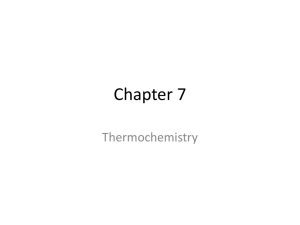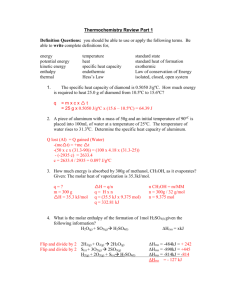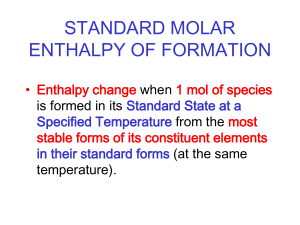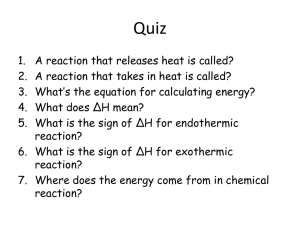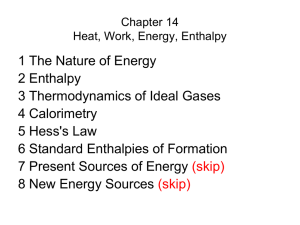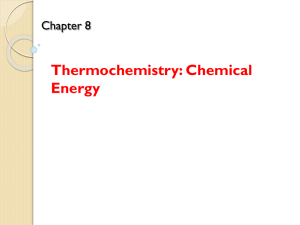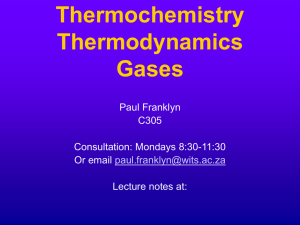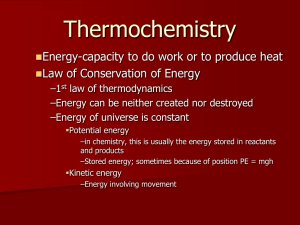File - Ms. Nickerson`s AP Chemistry
advertisement
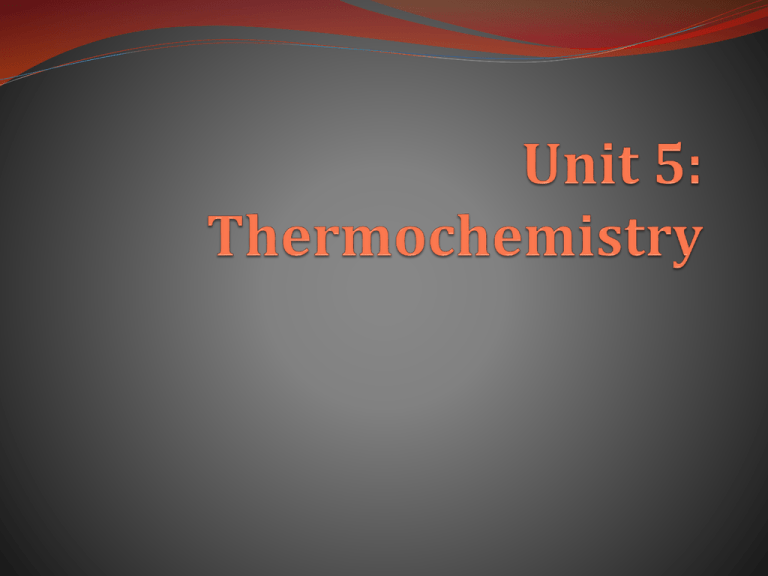
Thermochemistry looks at relationships between chemical reactions and energy changes involving heat. The SI unit of energy is the __joule___ (J). Because a joule is not a large amount of energy, we will often use the unit ____kilojoule_____ (kJ). Types of Energy – Kinetic energy – energy of motion; increases as the speed of an object increases – Potential energy – energy related to the position of an object; happens when a force is operating on (or acting upon) an object Work (w) – energy used to cause an object with mass to move against a force Force (F) – any kind of push or pull exerted on an object Heat – energy transferred from a hotter object to a colder one A combustion reaction (e.g. burning of natural gas) releases chemical energy stored in molecules of gas in the form of heat. Energy The capacity to do work or transfer heat • First Law of Thermodynamics can be summed up in one statement: ENERGY IS CONSERVED Any energy lost by the system must be gained by the surroundings or vice versa. • Internal energy – a sum of all the ___kinetic_____ and __potential___ energy of all the components in the system • The change in internal energy (ΔE) is the difference in energy before and after work is done or heat is transferred ΔE = Efinal – Einitial If ΔE > 0 (positive), then Efinal > Einitial If ΔE < 0 (negative), then Efinal < Einitial ΔE = q + w System +q −q Surroundings +w −w Enthalpy (H) is a function of thermodynamics. Accounts for __heat_ _flow__ in chemical changes occurring at: Constant pressure No forms of work are performed other than pressure-volume (PV) work ΔH represents the __change___ in enthalpy ΔH = qp System ΔH > 0 HEAT ΔH < 0 Endothermic HEAT Exothermic Surroundings Endothermic –the system absorbs heat; heat flows into the system from the surroundings Exothermic – the system evolves heat; heat flows out of the system into the surroundings Heat and Work Identify each energy exchange as heat or work and determine whether the sign of heat or work (relative to the system) is positive or negative: An ice cube melts and cools the surrounding beverage. (The ice cube is the system.) Heat and Work Identify each energy exchange as heat or work and determine whether the sign of heat or work (relative to the system) is positive or negative: A metal cylinder is rolled up a ramp. (The metal cylinder is the system.) Heat and Work Identify each energy exchange as heat or work and determine whether the sign of heat or work (relative to the system) is positive or negative: Steam condenses on skin, causing a burn. (The condensing steam is the system.) Internal Energy Problems (ΔE) Calculate ∆E for a system undergoing an endothermic process in which 15.6 kJ of heat flows and where 1.4 kJ of work is done on the system. A system absorbs 196 kJ of heat and the surroundings do 117 kJ of work on the system. What is the change in internal energy of the system? Internal Energy Problems (ΔE) A system releases 622 kJ of heat and does 105 kJ of work on the surroundings. What is the change in internal energy of the system? The gas in a piston (defined as the system) warms and absorbs 655 J of heat. The expansion performs 344 J of work on the surroundings. What is the change in internal energy for the system? The air in an inflated balloon (defined as the system) warms over a toaster and absorbs 115 J of heat. As it expands, it does 77 kJ of work. What is the change in internal energy for the system? Pressure-Volume Work When work is done involving a gas, work is a function of pressure. Work done by the expansion of a gas Pressure is defined as force per unit of area, so when the volume of a gas is changed work was either done on the gas or by the gas. work = −P∆V 101.3 J = 1 L·atm work = −P∆V To inflate a balloon you must do pressure-volume work on the surroundings. If you inflate a balloon from a volume of 0.100 L to 1.85 L against an external pressure of 1.00 atm, how much work is done (in Joules)? work = −P∆V A cylinder equipped with a piston expands against an external pressure of 1.58 atm. If the initial volume is 0.485 L and the final volume is 1.245 L, how much work (in J) is done? work = −P∆V When fuel is burned in a cylinder equipped with a piston, the volume expands from 0.255 L to 1.45 L against an external pressure of 1.02 atm. In addition, 875 J is emitted as heat. What is ΔE for the burning of the fuel? work = −P∆V The average human lunch expands by 0.50 L during each breath. If this expansion occurs against an external pressure of 1.0 atm, how much work (in J) is done during the expansion? Quantifying Heat Capacity (Calculating with Heat Capacity) Temperature is a measure of the thermal energy within a sample of matter. Heat is the transfer of thermal energy Thermal energy always flows from higher to lower temperatures. Heat transfer stops when the system and surroundings reach the same temperature, a condition called thermal equilibrium. Quantifying Heat Capacity (Calculating with Heat Capacity) When a system absorbs heat (q), its temperature changes by ΔT: HEAT (q) SYSTEM Heat absorbed by the system is directly proportional to its corresponding temperature change: 𝒒 ∝ ∆𝑻 Quantifying Heat Capacity (Calculating with Heat Capacity) Heat capacity (C) – a measuring of the system’s ability to absorb thermal energy without undergoing a large change in temperature Constant used in the formula The higher the heat capacity, the smaller the change in temperature when heat is absorbed 𝒒 J 𝑪= = ∆𝑻 ℃ Quantifying Heat Capacity (Calculating with Heat Capacity) Specific heat capacity (Cs)– the amount of heat required to raise the temperature of 1 gram of the substance by 1 °C. Each substance has its own specific heat capacity (or “specific heat”) Water’s specific heat = 4.184 J/°C Molar heat capacity – the amount of heat required to raise the temperature of 1 mole of a substance by 1 °C. Temperature Changes and Heat Capacity 𝒒 = 𝒎 × 𝑪𝒔 × ∆𝑻 Heat (J) Mass (grams) Specific Heat (J/g·°C) Change in temperature (°C) 𝒒 = 𝒎 × 𝑪𝒔 × ∆𝑻 Suppose you find a penny (minted before 1982, when pennies were almost entirely copper) in the snow. How much heat is absorbed by the penny as it warms from the temperature of the snow, which is 8.0 °C, to the temperature of your body, 37.0 °C? Assume the penny is pure copper and has a mass of 3.10 g. 𝒒 = 𝒎 × 𝑪𝒔 × ∆𝑻 How much heat is required to warm 150 g of sand from 25.0°C to 100.0°C? (The specific heat of sand is 0.84 J/°C.) How much heat is required to warm 1.50 L of water from 25.0°C to 100.0°C? (Assume the density of 1.0 g/mL for water.) 𝒒 = 𝒎 × 𝑪𝒔 × ∆𝑻 Suppose that 25 grams of each substance is initially at 27.0°C. What is the final temperature of each substance upon absorbing 2.35 kJ of heat? REMEMBER: ΔT = Tfinal - Tinitial GOLD SILVER Thermal Energy Transfer Heat transfers from the hotter object to the colder object. If we assume that the two objects are thermally isolated from everything else, then the heat lost by one substance exactly equals the heat gained by the other. This is according to the law of conservation of energy. If we define one substance as the system, and one as the surroundings, we can say: 𝒒𝒔𝒚𝒔 = − 𝒒𝒔𝒖𝒓𝒓 𝒒𝒔𝒚𝒔 = − 𝒒𝒔𝒖𝒓𝒓 Suppose a block of metal initially at 55°C is submerged into water initially at 25°C. Thermal energy transfers as heat from the metal to the water. qmetal = - qwater The metal will get colder and the water will get warmer until the two substances reach the same temperature (a.k.a. thermal equilibrium). The exact temperature change that occurs depends on the masses of the metal and the water, and on their specific heat capacities. Since 𝒒 = 𝒎𝑪𝒔 ∆𝑻, it follows that… 𝒒𝒎𝒆𝒕𝒂𝒍 = − 𝒒𝒘𝒂𝒕𝒆𝒓 𝒎𝒎𝒆𝒕𝒂𝒍 × 𝑪𝒔,𝒎𝒆𝒕𝒂𝒍 × ∆𝑻𝒎𝒆𝒕𝒂𝒍 = −𝒎𝒘𝒂𝒕𝒆𝒓 × 𝑪𝒔,𝒘𝒂𝒕𝒆𝒓 × ∆𝑻𝒘𝒂𝒕𝒆𝒓 A 32.5 g cube of aluminum initially at 45.8°C is submerged into 105.3 g of water at 15.4°C. What is the final temperature of both substances at thermal equilibrium? Metal Water X X m C Tf Ti ΔT A block of copper of unknown mass has an initial temperature of 65.4°C. The copper is immersed in a beaker containing 95.7 g of water at 22.7°C. When the two substances reach thermal equilibrium, the final temperature is 24.2°C. What is the mass of the copper block? Metal m C Tf Ti ΔT Water A 31.1 g wafer of pure gold, initially at 69.3°C, is submerged into an unknown mass of water at 64.2 g of water at 27.8°C in an insulated container. What is the final temperature of both substances at thermal equilibrium? Q: Substances A and B, initially at different temperatures, come in contact with each other and reach thermal equilibrium. The mass of substance A is twice the mass of substance B. The specific heat capacity of substance B is twice the specific heat capacity of substance A. Which statement is true about the final temperature of the two substances once thermal equilibrium is reached? a) The final temperature will be closer to the initial temperature of substance A than substance B. b) The final temperature will be closer to the initial temperature of substance B than substance A. c) The final temperature will be exactly midway between the initial temperature of substances A and B. CALORIMETRY: Measuring ° ∆𝐻𝑟𝑥𝑛 Bomb calorimetry – occurs at constant volume and measures ΔE for a reaction. Performed in a bomb calorimeter, a piece of equipment designed to measure ΔE for combustion reactions. Reaction occurs in a sealed container. Burn a sample inside the bomb and measure the temperature. ΔT is rlated to the heat absorbed by the calorimeter (qcal) by the equation: 𝒒𝒄𝒂𝒍 = 𝑪𝒄𝒂𝒍 × ∆𝑻 If no heat escapes from the calorimeter, then the amount of heat gained by the calorimeter exactly equals the heat released by the reaction: 𝒒𝒄𝒂𝒍 = − 𝒒𝒓𝒙𝒏 𝒒𝒓𝒙𝒏 ∆𝑬𝒓𝒙𝒏 = 𝒎𝒐𝒍𝒆𝒔 𝒒𝒓𝒙𝒏 𝒌𝑱 ∆𝑬𝒓𝒙𝒏 = = 𝒎𝒐𝒍𝒆𝒔 𝒎𝒐𝒍 𝒒𝒓𝒙𝒏 𝒌𝑱 ∆𝑬𝒓𝒙𝒏 = = 𝒎𝒐𝒍𝒆𝒔 𝒎𝒐𝒍 When 1.010 g of sucrose (C12H22O11) undergoes combustion in a bomb calorimeter, the temperature rises from 24.92°C to 28.33°C. Find ΔErxn for the combustion of sucrose in kJ/mol sucrose. The heat capacity of the bomb calorimeter, determined in a separate experiment, is 4.90 kJ/°C. When 1.550 g of liquid hexane (C6H14) undergoes combustion in a bomb calorimeter, the temperature rises from 25.87°C to 38.13°C. Find ΔErxn for the reaction in kJ/mol hexane. The heat capacity of the bomb calorimeter, determined in a separate experiment, is 5.73 kJ/°C. Thermochemical Equations Balanced chemical equation that also includes ΔHrxn, or heat of reaction Also known as “enthalpy of reaction” Extensive property – means that it depends on the amount of material undergoing the reaction. The ΔHrxn is for the stoichiometry amounts of reactants and products for the reaction AS WRITTEN. C3H8(g) + 5O2(g) 3CO2(g) + 4H2O(g) ΔHrxn = -2044 kJ The equation tells us that when 1 mol of C3H8 reacts with 5 mol of O2 to form 3 mol of CO2 and 4 mol of H2O, 2044 kJ of heat is released. We can use the coefficients with the ΔHrxn as a ratio of quantities: 1 mol C3H8 : -2044 kJ 5 mol O2 : -2044 kJ -2044 kJ 1 mol C3H8 -2044 kJ 5 mol O2 To determine the amount of released when a certain mass of C3H8 is combusted, use the following plan: g C3H8 kJ mol C3H8 1 mol C3H8 44.09 g C3H8 -2044 kJ 1 mol C3H8 Examples: An LP gas tank in a home barbeque contains 13.2 kg of propane, C3H8. Calculate the heat (in kJ) associated with the complete combustion of all the propane in the tank. C3H8(g) + 5O2(g) 3CO2(g) + 4H2O(g) ΔHrxn = -2044 kJ Examples: Ammonia reacts with oxygen according to the equation: 4NH3 (g) + 5O2 (g) 4NO (g) + 6H2O (g) ° ∆𝐻𝑟𝑥𝑛 = -906 kJ Calculate the heat (in kJ) associated with the complete reaction of 155 g of NH3. Examples: What mass of butane in grams is necessary to produce 1.5 x 103 kJ of heat? What mass of CO2 is produced? ° C4H10 (g) + 13 2O2 (g) 4 CO2 (g) + 5 H2O (g) ∆𝐻𝑟𝑥𝑛 = -906 kJ Examples: Consider the thermochemical equation for the combustion of acetone (C3H6O), the main ingredient in nail polish remover. C3H6O (l) + 4 O2 (g) 3 CO2 (g) + 3 H2O (g) ° ∆𝐻𝑟𝑥𝑛 = -1790 kJ If a bottle of nail polish remover contains 177 mL of acetone, how much heat is released by its complete combustion? The density of acetone is 0.788 g/mL. Examples: Charcoal is primarily carbon. Determine the mass of CO2 produced by burning enough carbon (in the form of charcoal) to produce 5.00 x 102 kJ of heat. C (s) + O2 (g) CO2 (g) ° ∆𝐻𝑟𝑥𝑛 = -393.5 kJ Examples: What mass of natural gas (CH4) must burn to emit 267 kJ of heat? CH4 (g) + 2 O2 (g) CO2 (g) + 2 H2O (g) ° ∆𝐻𝑟𝑥𝑛 = -802.3 kJ CALORIMETRY: Measuring ° ∆𝐻𝑟𝑥𝑛 Coffee-cup calorimetry – occurs at constant pressure and measures ΔH for a reaction. Used for aqueous reactions, or reactions taking place in water. Coffee cup calorimeter – equipment that insulates the reaction from the external environment The reaction occurs in a specifically measured quantity of solution within the calorimeter. Thermometer measures heat change of the solution. We assume the heat gained by the solution equals the heat lost by the reaction (or vice versa). CALORIMETRY: Measuring ° ∆𝐻𝑟𝑥𝑛 Thermometer measures heat change of the solution. We assume the heat gained by the solution equals the heat lost by the reaction (or vice versa). 𝒒𝒓𝒙𝒏 = − 𝒒𝒔𝒐𝒍𝒏 Since the reaction happens under constant pressure (open to the atmosphere), qrxn = ΔHrxn. To find the ΔHrxn per mole, then divide by the number of moles actually reacted. CALORIMETRY: Measuring ° ∆𝐻𝑟𝑥𝑛 Often times, you’ll make the following assumptions: The total volume of combined solutions is the sum of the two solutions. The specific heat of the aqueous solution is the specific heat of water. Game Plan: A. Find qsoln … 𝒒𝒓𝒙𝒏 = 𝒎𝒔𝒐𝒍𝒏 𝑪𝒔𝒐𝒍𝒏 ∆𝑻𝒔𝒐𝒍𝒏 All values related to SOLUTION B. Change sign for qsoln … 𝒒𝒓𝒙𝒏 = − 𝒒𝒔𝒐𝒍𝒏 Put in kJ if not already C. To find ΔHrxn in kJ/mol … 𝒒𝒓𝒙𝒏 ∆𝑯𝒓𝒙𝒏 = 𝒎𝒐𝒍𝒆𝒔 When a student mixes 50 mL of 1.0 M HCl and 50 mL of 1.0 M NaOH in a coffee- cup calorimeter, the temperature of the resultant solution incrases from 21.0°C to 27.5°C. Calculate the enthalpy change for the reaction in KJ/mol HCl. Assume the following: the total volume of the solution is 100.0 mL, the density is 1.0 g/mL, and the specific heat of the solution is that of water. When 50.0 mL of 0.100 M AgNO3 and 50.0 mL of 0.100 M HCl are mixed in a constant-pressure calorimeter, the temperature of the mixture increases from 22.3°C to 23.11°C. The temperature increase is caused by the following reaction: AgNO3(aq) + HCl(aq) AgCl(s) + HNO3(aq) ΔH = ? Calculate ΔH for this reaction in kJ/mol AgNO3, assuming that the combined solution has a mass of 100.0 g and a specific heat of 4.18 J/g·°C. When a 6.50-g sample of solid sodium hydroxide dissolves in 100.0 g of water in a coffee cup calorimeter, the temperature rises from 21.6°C to 37.8°C. Calculate ΔH (in kJ/mol NaOH) for the solution process: NaOH(s) Na+(aq) + OH-(aq) ΔH = ? Assume the specific heat of the solution is the same as pure water. When a 4.25-g sample of solid ammonium nitrate dissolves in 60.0 g of water in a coffee-cup calorimeter, the temperature drops from 22.0°C to 16.9°C. Calculate the ΔH (in kJ/mol NH4NO3) for the solution process: NH4NO3 (s) NH4+ (aq) + NO3-(aq) ΔH = ? Assume that the specific heat of the solution is the same as that of pure water. Potential Energy Diagrams Diagrams relative energies of reactants and products in a reaction. The difference between the levels represents the change in enthalpy (ΔH). Exothermic energy is released products have a lower energy ΔH arrow points down Endothermic energy is absorbed products have a higher energy ΔH arrow points up I. If a chemical equation is multiplied by some factor, then ΔHrxn is also multiplied by the same factor. A + 2B C 2A + 4B 2C ΔH1 ΔH2 = 2 x ΔH1 II. If a chemical equation is reversed, then ΔHrxn changes sign. A + 2B C ΔH1 C A + 2B ΔH2 = - ΔH1 A + 2B - ΔH1 ΔH1 C Use the thermochemical equation to determine the ΔH for the following: 2 H2 (g) + O2 (g) 2H2O (g) ΔH = -483.6 kJ 6H2 + 3O2 6H2O ΔH = ___________________ 2H2O 2H2 + O2 ΔH = ___________________ H2O H2 + ½ O2 ΔH = ___________________ H2 + ½ O2 H2O ΔH = ___________________ Use the thermochemical equation to determine the ΔH for the following: C3H8 (g) + 5 O2 (g) 3 CO2(g) + 4 H2O(g) ΔH = -2043 kJ 2 C3H8 (g) + 10 O2 (g) 6 CO2(g) + 8 H2O(g) ΔH = 6 CO2(g) + 8 H2O(g) 2 C3H8 (g) + 10 O2 (g) ΔH = 3 C3H8 (g) + 15 O2 (g) 9 CO2(g) + 12 H2O(g) ΔH = III. If a chemical equation can be expressed as the sum of a series of steps, then ΔHrxn for the overall equation is the sum of the heats of reactions for each step. Hess’s Law – the change in enthalpy for a stepwise process is the sum of the enthalpy changes of the steps. Summing the steps in a chemical reaction to determine ΔHrxn: A + 2B C C 2D A + 2B 2D ΔH1 ΔH2 ΔH3 = ΔH1 + ΔH2 Find ΔHrxn for the reaction: C (graphite) C (diamond) Use these reactions with known ΔH‘s: C (graphite) + O2 CO2 (g) CO2 (g) C (diamond) + O2 (g) ΔH = ? ΔH = -393.5 kJ ΔH = +395.4 kJ Find ΔHrxn for the reaction: CO (g) + 2 H2 (g) CH3OH (g) Use these reactions with known ΔH‘s: 2 CO (g) 2 C (s) + O2 (g) 2 C (s) + O2 (g) + 4 H2 (g) 2 CH3OH (g) ΔH = ? ΔH = + 221.0 kJ ΔH = - 402.4 kJ TYPO ALERT! No subscript of 2 here! Hess’s Law Calculations C (s) + H2O(g) CO (g) + H2(g) ΔHrxn = ? Find ΔHrxn for the reaction between C(s) and H2O(g) using the listed reactions with known ΔHrxn: C (s) + O2 (g) CO2 (g) ΔH = – 393.5 kJ 2 CO (g) + O2 (g) 2 CO2 (g) ΔH = – 566.0 kJ 2 H2 (g) + O2 (g) 2 H2O (g) ΔH = – 483.6 kJ TYPO ALERT! Should be 2 H2O . C (s) + H2O(g) CO2 (g) + H2(g) ΔHrxn = ? C (s) + O2 (g) CO2 (g) ΔH = – 393.5 kJ 2 CO (g) + O2 (g) 2 CO2 (g) ΔH = – 566.0 kJ 2 H2 (g) + O2 (g) H2O (g) ΔH = – 483.6 kJ 4 NH3 (g) + 5 O2 (g) 4 NO (g) + 6 H2O (g) N2 (g) + O2 (g) 2 NO (g) N2 (g) + 3 H2 (g) 2 NH3 (g) 2 H2 (g) + O2 (g) 2 H2O (g) ΔH = -180.5 kJ ΔH = -91.8 kJ ΔH = -483.6 kJ CH4 (g) + NH3 (g) HCN (g) + 3 H2 (g) N2 (g) + 3 H2 (g) 2 NH3 (g) C (s, graphite) + 2 H2 (g) CH4 (g) H2 (g) + 2 C (s, graphite) + N2 (g) 2 HCN (g) ΔH = -91.8 kJ ΔH = -74.9 kJ/mole ΔH = +270.3 kJ 2 Al (s) + 3 Cl2 (g) 2 AlCl3 (s) 2 Al (s) + 6 HCl (aq) 2 AlCl3 (aq) + 3 H2 (g) HCl (g) HCl (aq) H2 (g) + Cl2 (g) 2 HCl (g) AlCl3 (s) AlCl3 (aq) ΔH = -1049. kJ ΔH = -74.8 kJ/mole ΔH = -1845. kJ ΔH = -323. kJ/mole C2H4 (g) + H2 (g) C2H6 (g) C2H4 (g) + 3 O2 (g) 2 CO2 (g) + 2 H2O (l) C2H6 (g) + 7/2 O2 (g) 2 CO2 (g) + 3 H2O (l) H2 (g) + 1/2 O2 (g) H2O (l) ΔH = -1411. kJ ΔH = -1560. kJ ΔH = -285.8 kJ Enthalpies of Formation Enthalpies of Formation Standard States (for pure substances) For a gas: a pressure of exactly 1 atm For a liquid or solid: Substance in its most stable form, pressure of 1 atm, temperature of interest (usually 25°C) For a substance in solution: concentration of exactly 1 M Enthalpies of Formation Standard Enthalpy Change (ΔH°) The change in enthalpy for a process when all reactants and products are in their standard states. The degree sign (°) indicates standard states. Enthalpies of Formation Standard Enthalpy of Formation (∆𝐻𝑓° ) For a pure compound: The change in enthalpy when one mole of the compound forms from its constituent elements in their standard states. For a pure element in its standard state: ∆𝐻𝑓° = 0 Calculating the standard enthalpy change for a reaction ∆𝑯°𝒓𝒙𝒏 = 𝒏𝒑 ∆𝑯°𝒇 products − 𝒏𝒓 ∆𝑯°𝒇 reactants Sum np = # of moles (coefficient) for each product nr = # of moles (coefficient) for each reactant Keep in mind that elements in their standard states have ∆𝑯°𝒇 = 0. Use the standard enthalpies of formation to determine ° ∆𝐻𝑟𝑥𝑛 for the reaction: 4 NH3(g) + 5 O2(g) 4 NO(g) + 6 H2O(g) The thermite reaction, in which powdered aluminum reacts with iron oxide, is highly exothermic. Use standard enthalpies ° of formation to find ∆𝐻𝑟𝑥𝑛 for the thermite reaction. 2 Al(s) + Fe2O3(s) Al2O3(s) + 2 Fe(s) Using Standard Enthalpies of Formation to determine stoichiometric amounts ° 1. Use ∆𝐻𝑓° values to calculate ∆𝐻𝑟𝑥𝑛 for the overall reaction. 2. The thermochemical equation is the balanced chemical ° . equation with∆𝐻𝑟𝑥𝑛 3. Convert from kJ mol grams or vice versa (as we did on page 11). A city of 100,000 people uses approximately 1.0 x 1011 kJ of energy per day. Suppose all of that energy comes from the combustion of liquid octane (C8H18) to form gaseous water and gaseous carbon dioxide. Use standard ° enthalpies of formation to calculate ∆𝐻𝑟𝑥𝑛 for the combustion of octane and then determine how many kilograms of octane would be necessary to provide this amount of energy. The oxidation of iron forms iron oxide according to the equation: ° 4 Fe(s) + 3 O2(g) 2 Fe2O3(s). Calculate ∆𝐻𝑟𝑥𝑛 for this reaction and calculate how much heat is produced from a hand warmer containing 15.0 g of iron powder. Your turn to practice… 12th edition book, chapter 10: 72, 73, 75 Wagon Wheel For your topic: Important equations & information Create a word problem related to your topic Solve the word problem (and be able to explain the answer.) TOPICS: 1) Internal energy (combination of heat and work) 2) Calorimetry (using heat capacity to determine q) 3) Hess’s Law (using the Big Mamma equation)
